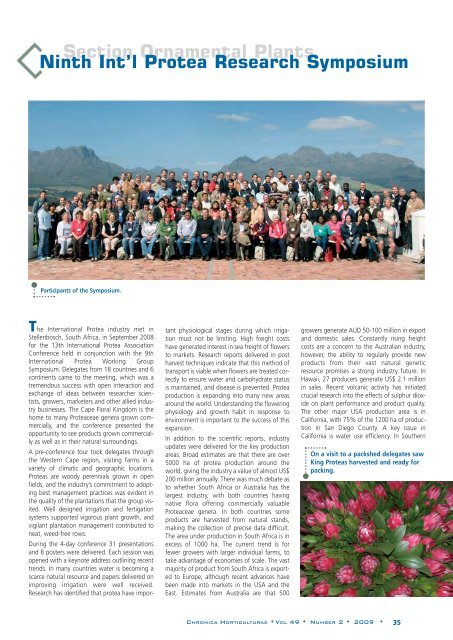Chronica Horticulturae volume 49 number 2 ... - Acta Horticulturae
Chronica Horticulturae volume 49 number 2 ... - Acta Horticulturae
Chronica Horticulturae volume 49 number 2 ... - Acta Horticulturae
You also want an ePaper? Increase the reach of your titles
YUMPU automatically turns print PDFs into web optimized ePapers that Google loves.
Section Ornamental Plants<br />
Ninth Int’l Protea Research Symposium<br />
Participants of the Symposium.<br />
The International Protea industry met in<br />
Stellenbosch, South Africa, in September 2008<br />
for the 13th International Protea Association<br />
Conference held in conjunction with the 9th<br />
International Protea Working Group<br />
Symposium. Delegates from 18 countries and 6<br />
continents came to the meeting, which was a<br />
tremendous success with open interaction and<br />
exchange of ideas between researcher scientists,<br />
growers, marketers and other allied industry<br />
businesses. The Cape Floral Kingdom is the<br />
home to many Proteaceae genera grown commercially,<br />
and the conference presented the<br />
opportunity to see products grown commercially<br />
as well as in their natural surroundings.<br />
A pre-conference tour took delegates through<br />
the Western Cape region, visiting farms in a<br />
variety of climatic and geographic locations.<br />
Proteas are woody perennials grown in open<br />
fields, and the industry’s commitment to adopting<br />
best management practices was evident in<br />
the quality of the plantations that the group visited.<br />
Well designed irrigation and fertigation<br />
systems supported vigorous plant growth, and<br />
vigilant plantation management contributed to<br />
neat, weed-free rows.<br />
During the 4-day conference 31 presentations<br />
and 8 posters were delivered. Each session was<br />
opened with a keynote address outlining recent<br />
trends. In many countries water is becoming a<br />
scarce natural resource and papers delivered on<br />
improving irrigation were well received.<br />
Research has identified that protea have important<br />
physiological stages during which irrigation<br />
must not be limiting. High freight costs<br />
have generated interest in sea freight of flowers<br />
to markets. Research reports delivered in post<br />
harvest techniques indicate that this method of<br />
transport is viable when flowers are treated correctly<br />
to ensure water and carbohydrate status<br />
is maintained, and disease is prevented. Protea<br />
production is expanding into many new areas<br />
around the world. Understanding the flowering<br />
physiology and growth habit in response to<br />
environment is important to the success of this<br />
expansion.<br />
In addition to the scientific reports, industry<br />
updates were delivered for the key production<br />
areas. Broad estimates are that there are over<br />
5000 ha of protea production around the<br />
world, giving the industry a value of almost US$<br />
200 million annually. There was much debate as<br />
to whether South Africa or Australia has the<br />
largest industry, with both countries having<br />
native flora offering commercially valuable<br />
Proteaceae genera. In both countries some<br />
products are harvested from natural stands,<br />
making the collection of precise data difficult.<br />
The area under production in South Africa is in<br />
excess of 1000 ha. The current trend is for<br />
fewer growers with larger individual farms, to<br />
take advantage of economies of scale. The vast<br />
majority of product from South Africa is exported<br />
to Europe, although recent advances have<br />
been made into markets in the USA and the<br />
East. Estimates from Australia are that 500<br />
growers generate AUD 50-100 million in export<br />
and domestic sales. Constantly rising freight<br />
costs are a concern to the Australian industry,<br />
however, the ability to regularly provide new<br />
products from their vast natural genetic<br />
resource promises a strong industry future. In<br />
Hawaii, 27 producers generate US$ 2.1 million<br />
in sales. Recent volcanic activity has initiated<br />
crucial research into the effects of sulphur dioxide<br />
on plant performance and product quality.<br />
The other major USA production area is in<br />
California, with 75% of the 1200 ha of production<br />
in San Diego County. A key issue in<br />
California is water use efficiency. In Southern<br />
On a visit to a packshed delegates saw<br />
King Proteas harvested and ready for<br />
packing.<br />
CHRONICA HORTICULTURAE •VOL <strong>49</strong> • NUMBER 2 • 2009 • 35
















